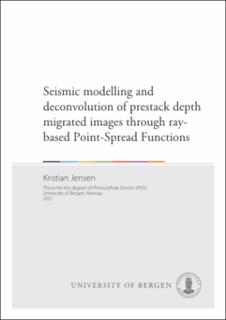| dc.contributor.author | Jensen, Kristian | |
| dc.date.accessioned | 2021-12-03T14:23:30Z | |
| dc.date.available | 2021-12-03T14:23:30Z | |
| dc.date.issued | 2021-12-15 | |
| dc.date.submitted | 2021-11-08T10:34:13.208Z | |
| dc.identifier | container/16/74/1e/78/16741e78-4f4b-4649-9c27-c19e739ffcb1 | |
| dc.identifier.isbn | 9788230845790 | |
| dc.identifier.isbn | 9788230851821 | |
| dc.identifier.uri | https://hdl.handle.net/11250/2832835 | |
| dc.description.abstract | Seismic modelling involves simulating the propagation of waves through an Earth model to retrieve information about the subsurface. If an a priori Earth model is known, seismic modelling allows geoscientists to assess how acquisition-, propagation- and processing parameters, may affect the obtained seismic image. Seismic modelling thus remains an important tool in exploration geophysics.
Due to restricted survey illumination, limited bandwidth frequencies and propagation effects in the overburden, seismic images typically yield a blurred and incomplete representation of the actual Earth model parameters. These limited-illumination and blurring effects are expressed through the local point scatterer responses, or point-spread functions. When accurately estimated point-spread functions are convolved with an input reflectivity grid, simulated prestack depth migrated images incorporating these effects are obtained. Conversely, if an accurate representation of the inverse point-spread functions can be estimated, seismic images may be deblurred, or deconvolved, to obtain a sharper, higher-resolution representation of the Earth model parameters.
Target-oriented point-spread functions may be estimated via different approaches. Wave-based approaches involve solving the acoustic or elastic wave equation, typically through the implementation of a Finite-Difference, or Finite-Element approach. These approaches are generally robust and accurate, but the computational cost involved may be prohibitive. Alternatively, ray-based approaches may be used. Ray-based approaches involve a high-frequency approximation of the wave equation, which significantly reduces computation time. As such, efficient and flexible estimations of point-spread functions may be obtained at a low computational cost, but inherent limitations in ray theory may lead to less accuracy.
The main objective of this thesis is to further validate, develop and improve a ray-based approach for estimation of point-spread functions. This approach utilizes a transformation which defines the point-spread functions in the wavenumber domain. Such an approach allows for fast computation of point-spread functions, as well as the possibility for quickly designing analytical point-spread functions tailored to specific needs.
First, an in-depth study of how ray-based point-spread functions compare to wave-based point-spread functions, is presented (Paper 1). The governing equations for both approaches are derived for the homogeneous case, thus allowing for a thorough assessment of the conditions where the two approaches may diverge. Simulated seismic images obtained via point-spread function convolution modelling are also compared to fully modelled and migrated data. The results reveal that both wave- and ray-based approaches accurately model illumination, resolution and amplitude effects observed in the fully migrated images. In addition, although some minor deviations between the wave-based and ray-based approaches are observed, the overall results, as also confirmed through the analysis of the governing equations, indicate that both approaches can be used, even for complex models.
Having validated the potential for ray-based point-spread functions to be used as convolution operators, the next study assesses how well such point-spread functions perform as seismic modelling operators on complex paleokarst geology (Paper 2). Due to the small-scale heterogeneity of paleokarst, wave-based modelling is inherently difficult to perform due to the high computational cost involved. However, precisely because of this small-scale heterogeneity, the ability to accurately simulate how perturbations of model- and seismic parameters affect paleokarst seismic images, is crucial. Through several case studies, different issues and challenges pertaining to seismic characterization and interpretation of paleokarst features are investigated. The validity of the point-spread function convolution approach is confirmed via comparisons with other seismic modelling work previously done on some of the same models.
Finally, the potential of applying ray-based point-spread functions as deconvolution operators on reverse-time migrated images is demonstrated (Paper 3). Ray-based point-spread functions are applied in an iterative conjugate-gradient algorithm for quick estimation of the local inverse Hessian operator valid at a target area of interest. Once estimated, this operator may be used for target-oriented deconvolution of seismic images. The validity of the approach is assessed through comparisons with results obtained from conventional source-signature deconvolution. The results reveal that the ray-based PSF deconvolution approach yields better resolution gain both vertically and laterally. | en_US |
| dc.language.iso | eng | en_US |
| dc.publisher | The University of Bergen | en_US |
| dc.relation.haspart | Paper 1: Jensen, K., Lecomte, I., Gelius, L.-J. and Kaschwich, T. (2021). Point-spread function convolution to simulate prestack depth migrated images: A validation study. Geophysical Prospecting, 69(8-9), pp. 1571-1590. The article is available in the thesis file. The article is also available at: <a href="https://doi.org/10.1111/1365-2478.13132" target="blank">https://doi.org/10.1111/1365-2478.13132</a> | en_US |
| dc.relation.haspart | Paper 2: Jensen, K., Johansen, M.K., Lecomte, I., Janson, X., Tveranger, J. and Kaschwich, T. (2021). Paleokarst reservoirs: Efficient and flexible characterization using point-spread-function-based convolution modeling. Interpretation, 9(2), pp. T331-T347. The article is not available in BORA due to publisher restrictions. The published version is available at: <a href=" https://doi.org/10.1190/INT-2020-0130.1" target="blank">https://doi.org/10.1190/INT-2020-0130.1</a> | en_US |
| dc.relation.haspart | Paper 3: Jensen, K., Lecomte, I., Arntsen, B., Wang, T., Kaur, H. and Decker, L. (2021). Deconvolution of reverse-time migrated images via ray-based pointspread functions. The article is not available in BORA. | en_US |
| dc.rights | Attribution (CC BY). This item's rights statement or license does not apply to the included articles in the thesis. | |
| dc.rights.uri | https://creativecommons.org/licenses/by/4.0/ | |
| dc.title | Seismic modelling and deconvolution of prestack depth migrated images through ray-based Point-Spread Functions | en_US |
| dc.type | Doctoral thesis | en_US |
| dc.date.updated | 2021-11-08T10:34:13.208Z | |
| dc.rights.holder | Copyright the Author. | en_US |
| dc.contributor.orcid | 0000-0002-9002-6591 | |
| dc.description.degree | Doktorgradsavhandling | |
| fs.unitcode | 12-50-0 | |

